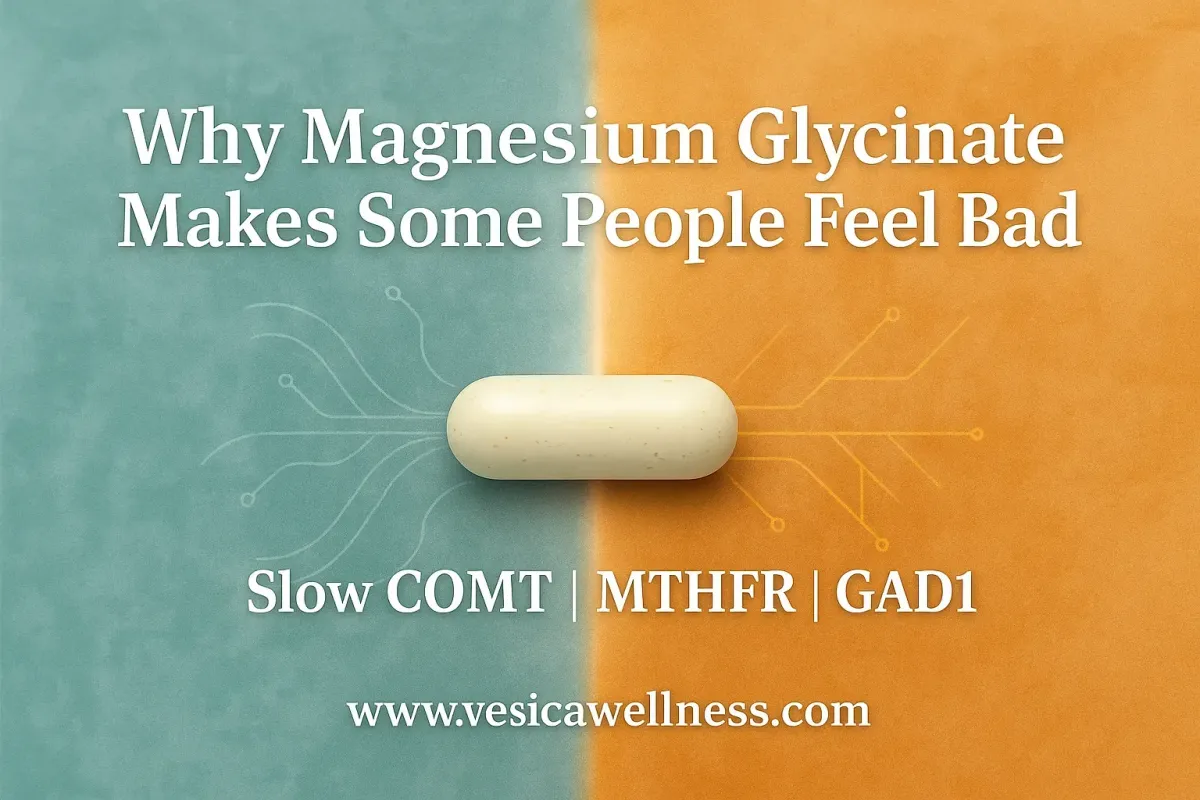
Why Magnesium Glycinate Makes Some People Feel Bad — and What to Do About It (Slow COMT | GAD1)
Disclaimer:This article is for educational purposes only and is not intended to diagnose, treat, cure, or prevent any disease. Always consult a qualified healthcare provider before beginning any new supplement or wellness protocol, especially if you have known genetic variations or health conditions.
Magnesium Glycinate: Gentle for Most, But Not for Everyone
Magnesium glycinate is one of the most popular forms of magnesium for calming support, sleep, and muscle relaxation. Because it’s bound to the amino acid glycine, it’s often described as one of the most bioavailable and “gentle on the stomach” forms available.
But here’s the truth: not everyone feels calm when they take it. For some, magnesium glycinate can trigger anxiety, irritability, brain fog, or restlessness. If this has happened to you, it doesn’t mean something is “wrong with you” — it means your biochemistry processes magnesium and glycine differently.
In this article, we’ll explore why magnesium glycinate makes some people feel bad, how this connects to glutamate, NMDA receptor activity, sodium/calcium balance, and GAD1 genetic variants, and what you can do to find a form of magnesium that supports, rather than overstimulates, your system.
Understanding the Glutamate–GABA Balance
Your brain constantly balances glutamate (excitation) and GABA (calmness).
Glutamate helps you focus, learn, and respond to stimuli — but too much can make you anxious or overstimulated.
GABA (gamma-aminobutyric acid) slows things down, promoting peace and rest.
The enzyme that converts glutamate into GABA is GAD1 (glutamic acid decarboxylase 1). If this pathway is slow — often due to a GAD1 SNP (genetic variant) or low vitamin B6 (a cofactor for this enzyme) — your brain can build up excess glutamate and lack the GABA “brake” that keeps you calm.
That’s where magnesium should help… but sometimes the opposite happens.
The NMDA Connection: Why Too Much “Calm” Can Backfire
Magnesium naturally blocks NMDA receptors — the same receptors activated by glutamate. This prevents excessive excitatory signaling and helps the nervous system relax.
However, magnesium glycinate is unique because it pairs magnesium with glycine — and glycine is actually a co-agonist for NMDA receptors.
In simple terms:
Magnesium = the “brake”
Glycine = one of the “keys” that unlocks NMDA activity
If your brain already has high glutamate or slow GABA conversion (from GAD1 variants), adding glycine can open the NMDA gate too wide — leading to more calcium and sodium rushing into neurons. This triggers overstimulation, restlessness, and sometimes even panic-like feelings.
It’s not that magnesium glycinate is “bad” — it’s just that for sensitive systems, the glycine portion can act like a double-edged sword.
The Role of Sodium, Calcium, and Magnesium Balance
Every thought, muscle twitch, and emotion depends on electrolyte balance. Magnesium, calcium, and sodium work like teammates — when one gets out of range, the others shift to compensate.
Magnesium relaxes muscles and neurons
Calcium contracts and excites
Sodium maintains electrical flow
If magnesium glycinate shifts this balance too quickly — especially in someone who’s already magnesium-replete or sensitive to glycine — the sudden change in ion movement (particularly through NMDA channels) can cause sensations like lightheadedness, agitation, or fatigue.
That’s why starting with a lower dose, using a different form, and supporting your magnesium supplementation with an electrolyte complex can make all the difference.
GAD1 Variants and the Glutamate “Overflow”
The GAD1 gene is responsible for producing GAD67, the enzyme that turns glutamate into GABA.
If this enzyme is less efficient — whether from genetics, low B6, chronic stress, or inflammation — you may build up more glutamate and have less GABA.
So when you take magnesium glycinate:
The glycine portion can fuel glutamate receptors (via NMDA).
The magnesium may enter neurons and shift calcium or sodium flow.
Without strong GABA activity (due to GAD1 inefficiency), the system lacks the “calming buffer.”
The result: you might feel anxious, foggy, or overstimulated, even though magnesium is generally calming.
This is why supporting GAD1 activity and overall neurotransmitter balance is key before or alongside magnesium glycinate supplementation.
Other Contributing Factors
Vitamin B6 deficiency: GAD1 needs active B6 (P-5-P) to convert glutamate to GABA.
Overmethylation: Too many methyl donors (like high-dose methyl B vitamins) can increase excitatory neurotransmission in some people.
Electrolyte imbalance: Low sodium or potassium can make magnesium feel “off.”
Timing: Taking glycinate late at night may overstimulate sensitive individuals.
Baseline magnesium status: If you’re not deficient, your body may not need much extra magnesium, making side effects more noticeable.
How to Know if Magnesium Glycinate Isn’t Right for You
You might notice:
Feeling wired but tired
Restlessness, racing thoughts, or agitation
Brain fog or confusion
Digestive discomfort
Poor sleep quality
Depressive symptoms
Feeling worse after several days of use
If this sounds familiar, your system may simply do better with a different forms of magnesium or a lower, split dose.
What to Do Instead
1. Try a Non-Glycinate Form of Magnesium
Magnesium Malate – Supports energy production, muscle recovery, and mitochondrial function; ideal for fatigue.
Magnesium Threonate – Crosses the blood–brain barrier; supports memory, cognition, and overall brain health.
Magnesium Taurate – Heart-protective; supports healthy blood pressure, rhythm, and calm focus.
Magnesium Aspartate – Enhances energy metabolism and athletic recovery; may aid muscle endurance.
Magnesium Citrate – Good for occasional constipation and mild muscle cramps; less ideal for sensitive digestion. It can also be helpful for sleep, focus, and brain fog, for some. If you try this one, to prevent loose stools, it's best to start low and work up until you find the right dosage for you.
Magnesium Orotate – Supports cardiovascular health and cellular energy (ATP production).
Magnesium L-Lactate – Gentle and well-tolerated; often used for those with sensitive stomachs.
2. Use a Magnesium Complex of Magnesium with Less Glycinate
We make a Magnesium Complex that is formulated with eight types of magnesium to get a wide arrange of benefits. Each form allows the magnesium to be absorbed by the body for it's own unique advantages.
It contains some Magnesium Glycinate, but because it's a small amount, it shouldn't cause any issues, especially if you're getting a good amount of B6 (P-5-P) to help convert the glycine into GABA, which you can find in other products we offer like our Methyl and Folinic Acid Complex Lozenges.
It contains the following forms of magnesium:
DiMagnesium Malate (Albion™)– (Supports energy production and muscle recovery through the Krebs cycle)
Magnesium Bisglycinate Chelate (TRAACS™)– (Highly bioavailable and gentle on the stomach; promotes calm and relaxation)
Magnesium Citrate– (Well-absorbed form that supports muscle function and regularity)
Magnesium Orotate– (Supports heart health and cellular energy through orotic acid synergy)
Magnesium Caprylate– (Provides digestive and metabolic support; associated with fatty acid metabolism)
Magnesium Lactate– (Gentle on digestion; supports energy and electrolyte balance)
Magnesium Taurinate– (Combines magnesium with taurine to support cardiovascular and nervous system health)
Magnesium Aspartate– (Helps with exercise recovery and cellular energy via the aspartate pathway)
2. Support GABA and GAD1 Activity Naturally
a. Ensure you’re getting enough Vitamin B6 (P-5-P), (which can be found in our following products):
Methylation Basics: B6 | Methyl Folate | Methylcobalamin B12
Methyl + Folinic B Complex Lozenges (for those who are sensitive to too much methylfolate)
b. Support healthy methylation balance with other B-Vitmains like methyfolate, folinic acid, adenosylcobalamin, methylcobalamin:
Methylfolate + Folinic Acid + Methyl B12 Lozenges — formulated for gentle, balanced B-vitamin activation.
*Note: if you're unsure which forms of folate and B12 you should be taking, it's important to note that some people get overstimulated by methylfolate and methylcobalamin. In that case, it's better to supplement with folate/folinic acid and either hydoxocobalamin or adenosylcobalamin.
Other supplements that help support healthy GABA levels include:
L-Theanine
Role: Promotes GABA synthesis, increases alpha-brain waves, and balances dopamine/serotonin.
Effect: Calm focus without sedation — great for daytime use or pre-sleep relaxation.
Taurine
Role: Functions as a GABA-like neuromodulator and stabilizes cell membranes.
Synergy: Works synergistically with magnesium and glycine to reduce excitatory firing.
Bonus: Taurine is also good for heart health and anti-aging.
➜ We include taurine in our Methyl Electrolyte Complex for this purpose.
Zinc + Vitamin B2
Zinc: Needed for proper GABA receptor structure and signaling.
Riboflavin (B2): Supports mitochondrial function of GAD1 enzyme indirectly.
➜ We include both of these in our multivitamin formulas for this purpose.
Lithium Orotate
Role: Enhances GABAergic transmission by increasing GABA synthesis and receptor sensitivity while reducing glutamate activity via NMDA inhibition.
Effect: Promotes emotional stability, calm focus, and protection against overstimulation or anxious rumination.
3. Balance Electrolytes and Go Slow
If you tend to react to supplements, start small:
¼ or ½ capsule per day
Take it with food
Avoid combining multiple “calming” agents at once
For those who do better with trace-based blends, the Methyl Electrolyte Complex provides magnesium in a synergistic formula that supports both cellular calm and balanced methylation without overstimulation.
Key Takeaways
✅ Magnesium glycinate isn’t “bad” — it’s just not ideal for every body type.
✅ The glycine portion can fuel NMDA activity in those with high glutamate or low GABA.
✅ GAD1 SNPs or low B6 can make it harder to calm the brain, leading to paradoxical anxiety.
✅ Supporting the GABA pathway and choosing a gentler magnesium form can make all the difference.
✅ Always start low, go slow, and listen to your body’s response.
A Final Word
At Vesica Wellness, our goal is to honor the way your body was designed — no synthetic shortcuts, no hidden fillers, just bioavailable support for your unique genetics.
Understanding that not all supplements work the same for everyone is part of the journey toward truly personalized, faith-rooted wellness.
If magnesium glycinate hasn’t worked well for you, you’re not alone — and with the right form, dosage, and nutrient support, peace and balance are within reach.
Be Sure to Join the MTHFR Support Group for Community
Hearing from others not only can help you, but it allows us to all further the knowledge about genetic SNPs.
Click here to join the MTHFR support community!




